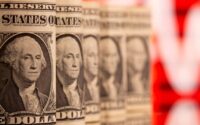St. Louis Fed’s Bullard says Fed still seems “behind the curve”
April 7 (Reuters) – The Federal Reserve remains behind in its fight against inflation despite increases in mortgage rates and government bond yields that have raced ahead of actual changes in the central bank’s target federal funds rate, St. Louis Fed president James Bullard said Thursday.
Using a standard monetary policy rule Bullard in prepared remarks to the University of Missouri said that even a “generous” interpretation shows the Fed’s short-term rate should currently be as high as 3.5%, rather than the current range of between 0.25% and 0.5%.
“U.S. inflation is exceptionally high, comparable to that in 1974 and 1983,” when U.S. central bankers lost control of the pace of price increases and ultimately had to use painfully restrictive interest rates to induce a recession, Bullard said.
Headline inflation, measured by the Fed’s preferred personal consumption expenditures price index, is currently 6.4%, triple the Fed’s 2% target. A different measure of “core” prices, which excludes often volatile food and energy costs, is a slightly lower 5.4%.
The current Fed policy rate, Bullard acknowledged, does not fully capture the financial “tightening” that already has taken place in markets based on investors’ expectations that the Fed will act more aggressively in coming months. The 2-year Treasury yield, for example, has risen from around 1.45% on March 1 to 2.45% on Thursday morning, and the interest rate on a 30-year home mortgage is approaching 5% versus recent lows below 3%.
But that “still leaves the Fed behind the curve,” Bullard said, noting that the central bank now has to “ratify” what markets believe by following through on rate increases at coming meetings.
Bullard did not in his prepared remarks expand on his recent calls for faster, half-point rate hikes at some of those sessions, or on his views of the balance sheet reduction plans detailed in Fed minutes released on Wednesday.
The minutes however showed many Fed officials in agreement about the need to raise rates in larger than the usual quarter-point increment. The balance sheet plan, which envisions trimming the Fed’s asset holdings by about $95 billion per month, had overnight pushed long-term interest rates higher, a further tightening of financial conditions. (Reporting by Howard Schneider Editing by Chizu Nomiyama)
[ad_2]
Source link


